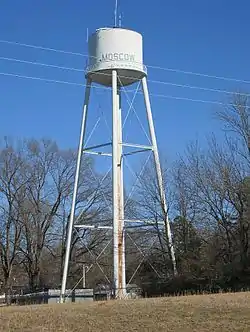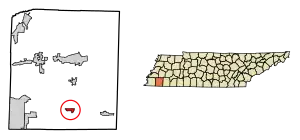Moscow, Tennessee
Moscow (/ˈmɒskoʊ/ MOS-koh) is a city in Fayette County, Tennessee, United States. The population was 556 at the 2010 census,[5] up from 422 at the 2000 census. The town was named after a Cherokee Chief [Mosgo], meaning "Town between 2 rivers." North Fork and Wolf Rivers. Army Corps of Engineers rerouted the waterways.
Moscow, Tennessee | |
|---|---|
 | |
 Location of Moscow in Fayette County, Tennessee. | |
| Country | United States |
| State | Tennessee |
| County | Fayette |
| Area | |
| • Total | 1.28 sq mi (3.33 km2) |
| • Land | 1.28 sq mi (3.31 km2) |
| • Water | 0.01 sq mi (0.02 km2) |
| Elevation | 354 ft (108 m) |
| Population (2010) | |
| • Total | 556 |
| • Estimate (2019)[2] | 557 |
| • Density | 436.52/sq mi (168.52/km2) |
| Time zone | UTC-6 (Central (CST)) |
| • Summer (DST) | UTC-5 (CDT) |
| ZIP code | 38057 |
| Area code(s) | 901 |
| FIPS code | 47-50300[3] |
| GNIS feature ID | 1294477[4] |
| Website | cityofmoscowtn |
Geography
Moscow is located in southern Fayette County at 35°3′40″N 89°23′59″W (35.060976, -89.399649),[6] at the confluence of the Wolf River with its North Fork.
Tennessee State Route 57 passes through the city, leading east 13 miles (21 km) to Grand Junction and west 15 miles (24 km) to Collierville. Downtown Memphis is 38 miles (61 km) to the west. Tennessee State Route 76 leads north from Moscow 13 miles (21 km) to Somerville, the Fayette County seat.
According to the United States Census Bureau, the city of Moscow has a total area of 1.2 square miles (3.2 km2), of which 0.01 square miles (0.02 km2), or 0.73%, is water.[5]
Demographics
| Historical population | |||
|---|---|---|---|
| Census | Pop. | %± | |
| 1880 | 193 | — | |
| 1890 | 201 | 4.1% | |
| 1910 | 211 | — | |
| 1920 | 314 | 48.8% | |
| 1930 | 296 | −5.7% | |
| 1940 | 309 | 4.4% | |
| 1950 | 394 | 27.5% | |
| 1960 | 368 | −6.6% | |
| 1970 | 448 | 21.7% | |
| 1980 | 499 | 11.4% | |
| 1990 | 384 | −23.0% | |
| 2000 | 422 | 9.9% | |
| 2010 | 556 | 31.8% | |
| 2019 (est.) | 557 | [2] | 0.2% |
| Sources:[7][8] | |||
As of the census[3] of 2000, there were 422 people, 172 households, and 108 families residing in the city. The population density was 340.8 people per square mile (131.4/km2). There were 185 housing units at an average density of 149.4 per square mile (57.6/km2). The racial makeup of the city was 68.96% White, 29.15% African American, 0.24% Native American, 0.47% from other races, and 1.18% from two or more races. Hispanic or Latino of any race were 1.18% of the population.
There were 172 households, out of which 18.6% had children under the age of 18 living with them, 41.9% were married couples living together, 18.6% had a female householder with no husband present, and 37.2% were non-families. 36.0% of all households were made up of individuals, and 23.8% had someone living alone who was 65 years of age or older. The average household size was 2.45 and the average family size was 3.24.
In the city, the population was spread out, with 20.9% under the age of 18, 10.9% from 18 to 24, 25.6% from 25 to 44, 22.3% from 45 to 64, and 20.4% who were 65 years of age or older. The median age was 39 years. For every 100 females, there were 76.6 males. For every 100 females age 18 and over, there were 70.4 males.
The median income for a household in the city was $33,021, and the median income for a family was $46,875. Males had a median income of $35,417 versus $21,346 for females. The per capita income for the city was $14,772. About 16.3% of families and 21.0% of the population were below the poverty line, including 21.1% of those under age 18 and 24.2% of those age 65 or over.
Battle of Moscow
Moscow was the site of a skirmish during the Civil War on December 4, 1863.[9] Confederate cavalry under the command of Gen. Stephen D. Lee attempted to burn the railroad bridge over the Wolf River, in order to aid Gen. Nathan Bedford Forrest in returning to Tennessee from Mississippi. They were thwarted by African-American Union troops who were stationed nearby. Union Gen. Stephen A. Hurlbut wrote of these troops in a dispatch dated December 17, 1863: "The recent affair at Moscow, Tennessee, has demonstrated the fact that colored troops, properly trained and disciplined, can and will fight well."[10]
Famous residents
Compton Newby Crook, who was born in Rossville, Tennessee, and who wrote science fiction under the pseudonym Stephen Tall, grew up in Moscow.[11]
Gallery
References
- "2019 U.S. Gazetteer Files". United States Census Bureau. Retrieved July 30, 2020.
- "Population and Housing Unit Estimates". United States Census Bureau. May 24, 2020. Retrieved May 27, 2020.
- "U.S. Census website". United States Census Bureau. Retrieved 2008-01-31.
- "US Board on Geographic Names". United States Geological Survey. 2007-10-25. Retrieved 2008-01-31.
- "Geographic Identifiers: 2010 Demographic Profile Data (G001): Moscow city, Tennessee". U.S. Census Bureau, American Factfinder. Retrieved August 16, 2016.
- "US Gazetteer files: 2010, 2000, and 1990". United States Census Bureau. 2011-02-12. Retrieved 2011-04-23.
- "Census of Population and Housing: Decennial Censuses". United States Census Bureau. Retrieved 2012-03-04.
- "Incorporated Places and Minor Civil Divisions Datasets: Subcounty Resident Population Estimates: April 1, 2010 to July 1, 2012". Population Estimates. U.S. Census Bureau. Archived from the original on 11 June 2013. Retrieved 11 December 2013.
- Morton, Dorothy Rich. Fayette County. Memphis State University Press: 1989. ISBN 0-87870-132-X. p. 83
- "Battle of Moscow – Moscow – TN – US". Historical Marker Project. Retrieved 2019-06-26.
- Morton 1989. pp. 56-57
| Wikimedia Commons has media related to Moscow, Tennessee. |





